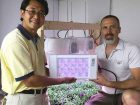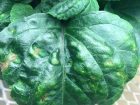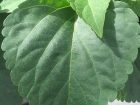
Features
Lighting
Structures & Equipment
Lighting in the limelight
Michigan symposium clearly illuminates what we know and don’t know about lighting for plants in controlled environment.
September 14, 2016 By Dr. Youbin Zheng and Dave Llewellyn
 Dr. Youbin Zheng and research associate Dave Llewellyn.
Dr. Youbin Zheng and research associate Dave Llewellyn. October 2016 – Lighting is one of the most important inputs in controlled environment (ex. greenhouse and plant factories) plant production that we have the ability to manage in order to achieve our production goals. There is an astounding variability in how plants utilize light for photosynthesis as well as perceive and respond to their lighting environment.
However, the strategies and effects of modifying the lighting environment (i.e. intensity and spectral quality) in order to achieve specific production outcomes are often poorly understood or even misunderstood.
In this article, we will summarize some of the interesting points, including some challenges to old ideas, that were discussed at the VIII International Symposium on Light in Horticulture, May 22-26, 2016, Michigan, U.S.A., that are particularly relevant to crop production.
At this symposium, there were 245 participants from all over the world with most of the world’s horticulture lighting experts and suppliers gathered under one roof. It’s almost unbelievable how much more we have learned from horticultural lighting research in the past decade, and how much more we still do not know. We were also struck by how many concepts about crop/light interactions found in textbooks are now being challenged. Many of these advancements have arisen directly from recent developments in LED technologies, which have opened the doors to practically limitless research and application opportunities in spectral science.
To make this article easy to read, we will do it in point form.
For some basic horticultural lighting background you may like to read our previous article in this magazine’s March 2016 issue entitled “Are LEDs the right choice for my operation?.” Among other topics, this article highlights the differences between HPS and newer LED technologies.
- The photon efficiency (i.e. quantity of photosynthetically active radiation [PAR, 400 to 700 nm] produced per unit energy input, normally described as µmol [PAR] J-1) of LEDs has been continuously getting better.
A paper published by Nelson and Bugbee in 2014 stated that “the two most efficient LED and the two most efficient double-ended HPS fixtures had nearly identical efficiencies at 1.66 to 1.70 micromoles per joule.” Only two years later, Dr. A.J. Both described one commercial LED fixture that had a photon efficiency of 2.39 µmol J-1, which is about 30 per cent more efficient as the best double-ended HPS they measured. With so many commercial companies working on the LED technologies, we expect the photon efficiency of LED technologies to continue to improve. - Some LED companies are able to provide fixtures with control systems to adjust light intensity (sometimes wirelessly, through software). There is strong potential to integrate intensity control into feedback systems that could adjust supplemental light levels based on instantaneous ambient light levels, weather predictions and crop requirements. Work is also being done towards developing feedback control systems to control light quality (i.e., spectra) in order to provide plants with the right lighting recipes. This is more challenging due to the lack of information on the specific needs of different plant species and grown in different environments. By using these feedback systems, LEDs can further save energy in plant production compared to other lighting technologies that have fixed intensities and spectral combinations.
- One of the main reasons that the LEDs found in many commercial horticultural fixtures are predominantly only red and blue is because the “typical” photosynthetic action spectra, which was described almost 50 years ago using chloroplasts harvested from rye plants, identified that red and blue light can produce relatively higher photosynthetic rates than other wavelengths in the PAR spectrum. As a result, many textbooks tell us that green light (500 to 600 nm) is the least effective wavelength range in the PAR spectrum for driving photosynthesis because plants reflect the majority of the green light; hence their colour is green.
While this may be true with harvested chloroplasts or single leaf measurements, it is not necessarily true in most plant stands where plants are grown with dense canopies (i.e., > one layer of leaves). While red and blue light are efficiently absorbed by the upper leaves in a canopy, green light can penetrate the upper canopy and be utilized for photosynthesis in lower leaves. Further, depending on leaf morphology, green light can penetrate further into a leaf in some circumstances, potentially increasing the total (per leaf) photosynthesis over red or blue alone.
Some research has shown that in some cases green light can even drive photosynthesis more efficiently than red. Light not only drives photosynthesis, it also influences plant morphology (e.g., shape). Certain light spectra can modify the growth habit and leaf morphology of some plants, enabling them to capture more light, therefore increasing the whole-plant light use efficiency.
The light output from many commercially available horticultural LEDs (predominantly red and blue light, often 80 to 95 per cent red) appears as magenta to the human eye. This colour is unpleasant for some people to work in and it is difficult to visually assess plants for disease and other disorders (ex., nutrient deficiencies). Adding a small amount of green light to red and blue can result in a much “whiter” light, which is better for the workers. - Far red light (700 to 800nm) is not part of PAR because it is not directly involved in photosynthesis. However, in some scenarios, supplemental FR has shown to boost photosynthetic rates beyond what could be expected for an equal input of PAR photons. This so-called “Emerson Enhancement Effect” is not well understood and it is not yet clear if there are any practical benefits in production scenarios. That said, recent research has also indicated numerous other potential benefits of supplemental far red in both vegetable and floriculture production, including: increased biomass production, stimulation of root development in cuttings, higher concentrations of phytochemicals, higher fruit yields and reduced morphological abnormalities.
- Some research showed that plants grow smaller when lighted with artificial PAR having more than 5-10 per cent blue photons. The main reason is that blue light can inhibit cell division and therefore cause smaller leaf area. Further, blue light has been shown to increase rooting in cuttings and the production of root biomass. These functions of blue light can be used to produce more compact plants with stronger roots.
The red+blue spectra typical of most commercially available horticultural LED fixtures is adequate as supplemental lighting in most greenhouse production scenarios. However, there is an increasing understanding that additional wavelengths (ex. UV, green and far red) are needed in many sole-source scenarios, such as plant factories, in order to prevent abnormalities such as intumescence injury (see Photo 1), and ensure optimal colour and nutrient content (including phytochemicals). It has been shown that these additional light spectra normally are not needed at very high intensities (relative to red and blue) or even all the time. - For example, Dr. Kubota’s group at Arizona University showed that by supplying far red at 6.0 µmol m-2 s-1 for only three minutes at the end of each day can significantly reduce the intumescence injury on tomato leaves when tomato seedlings were grown under 100 per cent artificial light.
- There is some potential for using supplemental UV for different purposes in plant production. For example, UV-C (100-280 nm) can be used for pathogen and insect control, to increase branching, reduce height and control the speed of flowering of ornamental crops. Low-pressure mercury vapour lamps, which have a peak output at 254 nm, are effective at producing germicidal doses of UV-C. UV-B (280-320 nm), can be used to pre-treat transplants to make them hardier (i.e., less prone to other stresses such as excessive light, pathogen etc.) before being transplanted to the field, can be used to enhance accumulation of secondary metabolites (e.g., flavonoids and terpenoids/isoprenoids), and can be used to control branching and height. Night-time exposure to UV-B has been shown to control powdery mildew on cucumber plants. UV-A (320-400 nm) can act similar to blue light for height control and enhancement of certain secondary metabolites. Currently, the energy use efficiency of UV- LEDs is still low and more improvements are needed if LED technology is to be used to provide UV light in controlled environment horticulture applications.
- LEDs do not radiate much direct heat; therefore research showed that by placing the light fixtures within the plant canopy (ex., intracanopy or shining from bottom up) had some success in improving production in vine crops such as high-wire tomatoes and cucumbers.
- Light spectra, light intensity and photoperiod can all be used to manipulate the quality of certain vegetable and medicinal crops. For example, some research showed that high intensity red light can be used to reduce the nitrate and nitrite content in leafy vegetables such as lettuce and increase the concentration of beneficial metabolites (ex., phenolics). The interaction between lighting and nutrient uptake seems to be different for different plant species and nutrient supplies.
- LEDs can be used for regulating plant flowering. For example, Dr. Runkle’s group at Michigan State University showed that for low intensity lighting (i.e., photoperiodic lighting, 1-4 µmol m-2 s-1), a moderate ratio of red to far red radiation promotes flowering of long-day plants, while only red radiation is needed to inhibit flowering of short-day plants.
- Plants’ response to light seems to vary considerably between different plant species, different cultivars and even the same plant at different stages of maturity. Therefore, it is very important to find out the specific lighting needs (i.e., intensity and spectrum) of one’s own crop(s).
For example, a group of researchers at Wageningen University grew nine tomato genotypes (i.e., same species) under either 100 per cent red or 88 per cent red and 12 per cent blue light and found that only seven out of the nine genotypes showed changes in biomass production between the lighting treatments, and the red/blue combination increased chlorophyll and flavonol contents only in three genotypes. It may be that each crop will have its individual ‘optimum’ lighting recipe (i.e., light level, light spectra combination and photo period). Understanding the impacts of manipulating the light environment may be especially profitable for some of the higher value crops that are grown in controlled environments. - In the field of spectral science, considerable research has already been conducted on some edible and ornamental crops but not others. For example, many studies have already investigated the influence of lighting on greenhouse production of tomato, cucumber, pepper, strawberry and basil as well as indoor production of lettuce, kale, strawberry and basil. While there is still much to learn about how artificial lighting can be used to optimize the production of these commodities, the knowledge-base for other crops such as medicinal and many ornamental commodities is even more limited.
In conclusion, there has recently been a rapid increase in plant lighting research thanks to the invention of LED lighting technologies; however, there are many things we still do not know. What is clear is that extreme caution should be exercised when extrapolating lighting research results from one cropping scenario to another. We strongly advise growers to search the (scientific) literature to find out the light requirements of their own crops. It is also highly advisable to take what can be learned in the literature and apply it to trials in their specific cropping setting. It is best to understand the influence of a specific lighting regimen (i.e., intensity and spectral distribution) before scaling up to a full production scenario. This is especially true for growing plants under 100 per cent artificial lighting.
Dr. Youbin Zheng (yzheng@uoguelph.ca) is an associate professor and Environmental Horticulture Chair at the University of Guelph and is also a researcher at the Vineland Research and Innovation Centre; Dave Llewellyn (dllewell@uoguelph.ca) is a research associate at Dr. Zheng’s Guelph lab who has extensive experience working with lighting technologies in research and production environments.
Print this page


